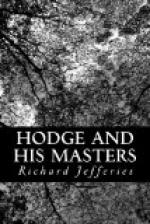The remarkable power of wind upon leaves is sometimes seen in May, when a strong gale, even from the west, will so beat and batter the tender horse-chestnut sprays that they bruise and blacken. The slow plough traverses the earth, and the white dust rises from the road and drifts into the field. In winter the distant copse seemed black; now it appears of a dull reddish brown from the innumerable catkins and buds. The delicate sprays of the birch are fringed with them, the aspen has a load of brown, there are green catkins on the bare hazel boughs, and the willows have white ‘pussy-cats.’ The horse-chestnut buds—the hue of dark varnish—have enlarged, and stick to the finger if touched; some are so swollen as to nearly burst and let the green appear. Already it is becoming more difficult to look right through the copse. In winter the light could be seen on the other side; now catkin, bud, and opening leaf have thickened and check the view. The same effect was produced not long since by the rime on the branches in the frosty mornings; while each smallest twig was thus lined with crystal it was not possible to see through. Tangled weeds float down the brook, catching against projecting branches that dip into the stream, or slowly rotating and carried apparently up the current by the eddy and back-water behind the bridge. In the pond the frogs have congregated in great numbers; their constant ‘croo-croo’ is audible at some distance.
The meadows, so long bound by frost and covered with snow, are slowly losing their wan aspect, and assuming a warmer green as the young blades of grass come upwards. Where the plough or harrow has passed over the clods they quickly change from the rich brown of fresh-turned soil to a whiter colour, the dryness of the atmosphere immediately dissipating the moisture in the earth. So, examine what you will, from the clod to the tiniest branch, the hedge, the mound, the water—everywhere a step forward has been taken. The difference in a particular case may be minute; but it is there, and together these faint indications show how closely spring is approaching.
As the sun rises the chaffinch utters his bold challenge on the tree; the notes are so rapid that they seem to come all at once. Welcome, indeed, is the song of the first finch. Sparrows are busy in the garden—the hens are by far the most numerous now, half a dozen together perch on the bushes. One suddenly darts forth and seizes a black insect as it flies in the sunshine. The bee, too, is abroad, and once now and then a yellow butterfly. From the copse on the warmer days comes occasionally the deep hollow bass of the wood pigeon. On the very topmost branch of an elm a magpie has perched; now he looks this way, and then turns that, bowing in the oddest manner, and jerking his long tail up and down. Then two of them flutter across the field—feebly, as if they had barely strength to reach the trees in the opposite hedge. Extending their wings they float slowly, and every now and then the body undulates along its entire length. Rooks are building—they fly and feed now in pairs; the rookery is alive with them. To the steeple the jackdaws have returned and fly round and round; now one holds his wings rigid and slides down at an angle of sixty degrees at a breakneck pace, as if about to dash himself in fragments on the garden beneath.




